本文介紹了canvas手機的手勢解鎖,分享給大家,順便給自己留個筆記����,廢話不多說����,具體如下:
按照國際慣例��,先放效果圖
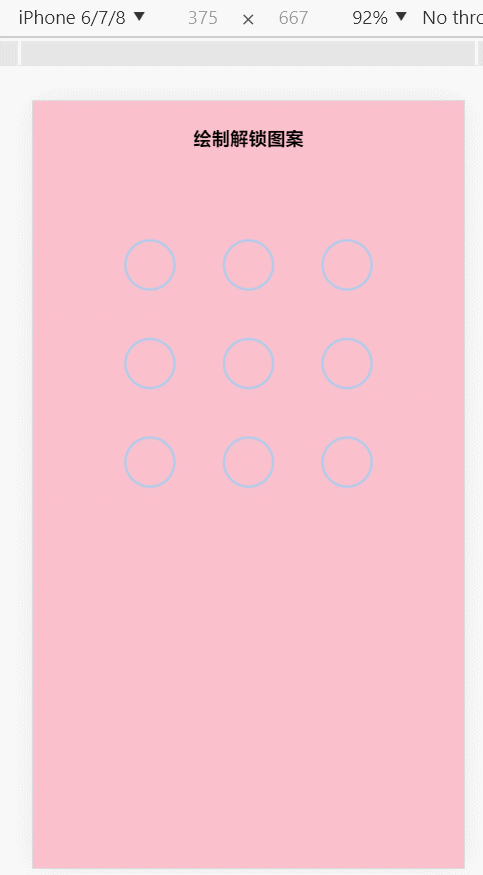
1、js動態初始化Dom結構
首先在index.html中添加基本樣式
body{background:pink;text-align: center;}
加個移動端meta頭
<meta name="viewport" content="width=device-width,initial-scale=1.0,user-scalable=no">
引入index.js腳本
<script src="index.js"></script>
index.js
// 匿名函數自執行
(function(){
// canvasLock是全局對象
window.canvasLock=function(obj){
this.width=obj.width;
this.height=obj.height;
}
//動態生成DOM
canvasLock.prototype.initDom=function(){
//創建一個div
var div=document.createElement("div");
var h4="<h4 id='title' class='title'>繪制解鎖圖案</h4>";
div.innerHTML=h4;
div.setAttribute("style","position:absolute;top:0;left:0;right:0;bottom:0;");
//創建canvas
var canvas=document.createElement("canvas");
canvas.setAttribute("id","canvas");
//cssText 的本質就是設置 HTML 元素的 style 屬性值
canvas.style.cssText="background:pink;display:inine-block;margin-top:15px;";
div.appendChild(canvas);
document.body.appendChild(div);
//設置canvas默認寬高
var width=this.width||300;
var height=this.height||300;
canvas.style.width=width+"px";
canvas.style.height=height+"px";
canvas.width=width;
canvas.height=height;
}
//init代表初始化����,程序的入口
canvasLock.prototype.init=function(){
//動態生成DOM
this.initDom();
//創建畫布
this.canvas=document.getElementById("canvas");
this.ctx=this.canvas.getContext("2d");
}
})();
在index.html中創建實例并初始化
new canvasLock({}).init();
效果圖
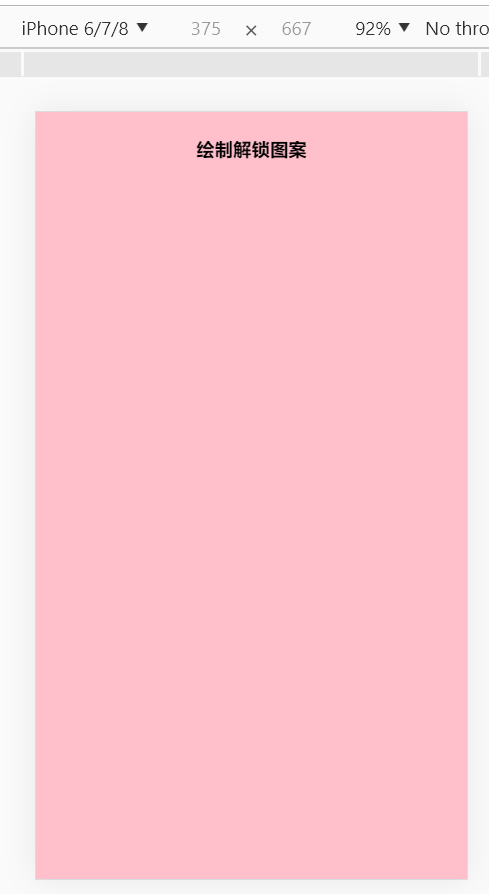
2����、 畫圓函數
需要補充一下畫布寬度與圓的半徑的關系
如果一行3個圓��,則有4個間距�,間距的寬度與圓的直徑相同�,相當于7個直徑,即14個半徑
如果一行4個圓,則有5個間距��,間距的寬度與圓的直徑相同�,相當于9個直徑,即18個半徑
如果一行n個圓,則有n+1個間距��,間距的寬度與圓的直徑相同�,相當于2n+1個直徑�,即4n+2個半徑
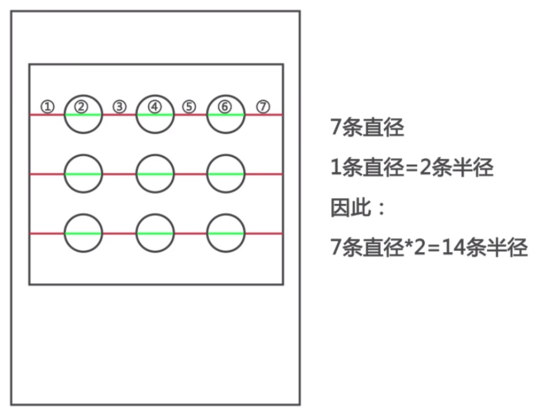
補充兩個方法:
//以給定坐標點為圓心畫出單個圓
canvasLock.prototype.drawCircle=function(x,y){
this.ctx.strokeStyle="#abcdef";
this.ctx.lineWidth=2;
this.ctx.beginPath();
this.ctx.arc(x,y,this.r,0,2*Math.PI,true);
this.ctx.closePath();
this.ctx.stroke();
}
//繪制出所有的圓
canvasLock.prototype.createCircle=function(){
var n=this.circleNum;//一行幾個圓
var count=0;
this.r=this.canvas.width/(4*n+2);//公式計算出每個圓的半徑
this.lastPoint=[];//儲存點擊過的圓的信息
this.arr=[];//儲存所有圓的信息
this.restPoint=[];//儲存未被點擊的圓的信息
var r=this.r;
for(var i=0;i<n;i++){
for(var j=0;j<n;j++){
count++;
var obj={
x:(4*j+3)*r,
y:(4*i+3)*r,
index:count//給每個圓標記索引
};
this.arr.push(obj);
this.restPoint.push(obj);//初始化時為所有點
}
}
//清屏
this.ctx.clearRect(0,0,this.canvas.width,this.canvas.height);
//以給定坐標點為圓心畫出所有圓
for(var i=0;i<this.arr.length;i++){
//循環調用畫單個圓的方法
this.drawCircle(this.arr[i].x,this.arr[i].y);
}
}
初始化的時候記得調用
canvasLock.prototype.init=function(){
//動態生成DOM
this.initDom();
//創建畫布
this.canvas=document.getElementById("canvas");
this.ctx=this.canvas.getContext("2d");
//繪制出所有的圓
this.createCircle();
}
別忘了在index.html中實例化時傳入參數(一行定義幾個圓)
new canvasLock({circleNum:3}).init();
效果圖
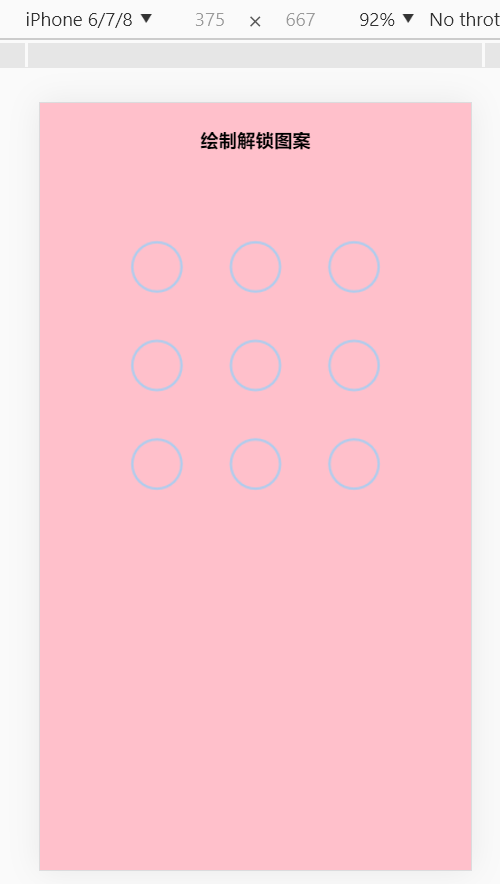
3��、canvas事件操作——實現畫圓和畫線
getPosition方法用來得到鼠標觸摸點離canvas的距離(左邊和上邊)
canvasLock.prototype.getPosition=function(e){
var rect=e.currentTarget.getBoundingClientRect();//獲得canvas距離屏幕的上下左右距離
var po={
//鼠標與視口的左距離 - canvas距離視口的左距離 = 鼠標與canvas的左距離
x:(e.touches[0].clientX-rect.left),
//鼠標與視口的上距離 - canvas距離視口的上距離 = 鼠標距離canvas的上距離
y:(e.touches[0].clientY-rect.top)
};
return po;
}
給canvas添加 touchstart 事件��,判斷觸摸點是否在圓內
觸摸點在圓內則允許拖拽,并將該圓添加到 lastPoint 中,從 restPoint 中剔除
this.canvas.addEventListener("touchstart",function(e){
var po=self.getPosition(e);//鼠標距離canvas的距離
//判斷是否在圓內
for(var i=0;i<self.arr.lenth;i++){
if(Math.abs(po.x-self.arr[i].x)<self.r && Math.abs(po.y-self.arr[i].y)<self.r){
self.touchFlag=true;//允許拖拽
self.lastPoint.push(self.arr[i]);//點擊過的點
self.restPoint.splice(i,1);//剩下的點剔除這個被點擊的點
break;
}
}
},false);
判斷是否在圓內的原理:
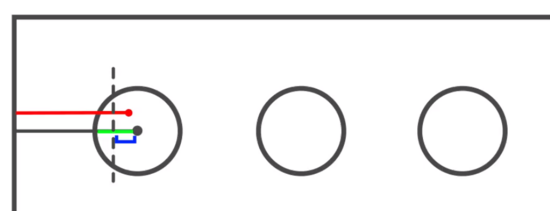
圓心的x軸偏移和鼠標點的x軸偏移的距離的絕對值小于半徑
并且
圓心的y軸偏移和鼠標點的y軸偏移的距離的絕對值小于半徑
則可以判斷鼠標位于圓內
給touchmove綁定事件����,在觸摸點移動時給點擊過的圓畫上實心圓����,并畫線
//觸摸點移動時的動畫
canvasLock.prototype.update=function(po){
//清屏����,canvas動畫前必須清空原來的內容
this.ctx.clearRect(0,0,this.canvas.width,this.canvas.height);
//以給定坐標點為圓心畫出所有圓
for(var i=0;i<this.arr.length;i++){
this.drawCircle(this.arr[i].x,this.arr[i].y);
}
this.drawPoint();//點擊過的圓畫實心圓
this.drawLine(po);//畫線
}
//畫實心圓
canvasLock.prototype.drawPoint=function(){
for(var i=0;i<this.lastPoint.length;i++){
this.ctx.fillStyle="#abcdef";
this.ctx.beginPath();
this.ctx.arc(this.lastPoint[i].x,this.lastPoint[i].y,this.r/2,0,2*Math.PI,true);
this.ctx.closePath();
this.ctx.fill();
}
}
//畫線
canvasLock.prototype.drawLine=function(po){
this.ctx.beginPath();
this.lineWidth=3;
this.ctx.moveTo(this.lastPoint[0].x,this.lastPoint[0].y);//線條起點
for(var i=1;i<this.lastPoint.length;i++){
this.ctx.lineTo(this.lastPoint[i].x,this.lastPoint[i].y);
}
this.ctx.lineTo(po.x,po.y);//觸摸點
this.ctx.stroke();
this.ctx.closePath();
}
效果圖
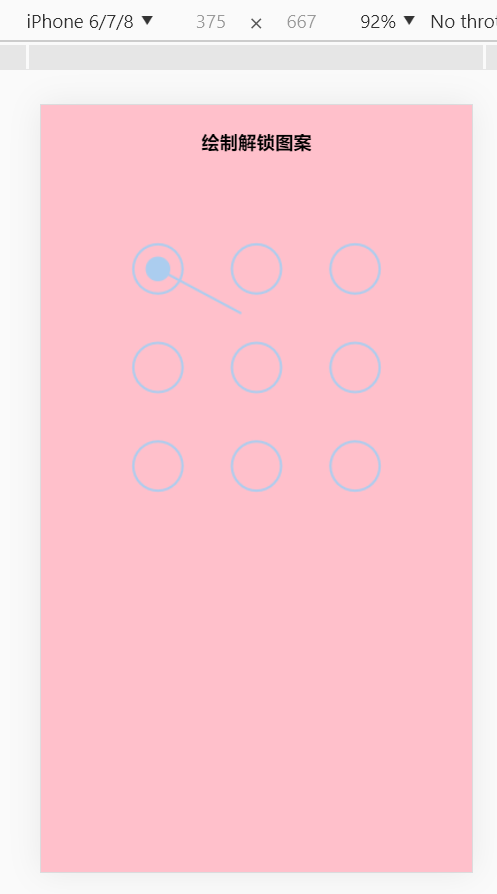
4��、canvas手勢鏈接操作實現
在touchmove中補充當碰到下一個目標圓時的操作
//碰到下一個圓時只需要push到lastPoint當中去
for(var i=0;i<this.restPoint.length;i++){
if((Math.abs(po.x-this.restPoint[i].x)<this.r) && (Math.abs(po.y-this.restPoint[i].y)<this.r)){
this.lastPoint.push(this.restPoint[i]);//將這個新點擊到的點存入lastPoint
this.restPoint.splice(i,1);//從restPoint中剔除這個新點擊到的點
break;
}
}
效果圖
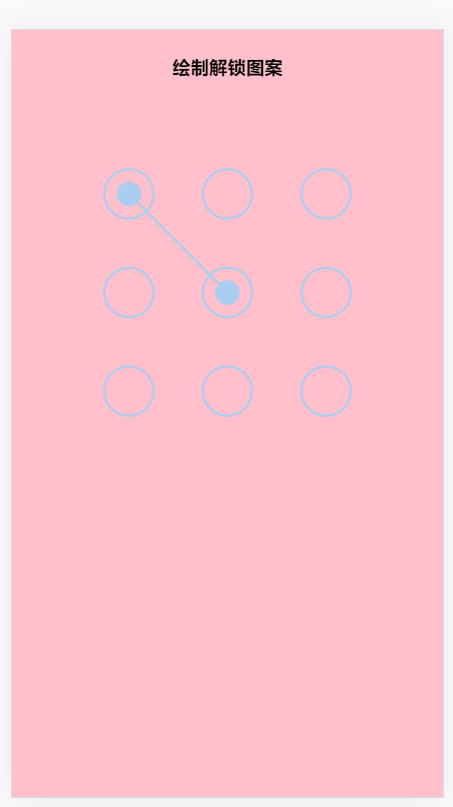
5����、解鎖成功與否的判斷
//設置密碼
canvasLock.prototype.storePass=function(){
if(this.checkPass()){
document.getElementById("title").innerHTML="解鎖成功";
this.drawStatusPoint("lightgreen");
}else{
document.getElementById("title").innerHTML="解鎖失敗";
this.drawStatusPoint("orange");
}
}
//判斷輸入的密碼
canvasLock.prototype.checkPass=function(){
var p1="123",//成功的密碼
p2="";
for(var i=0;i<this.lastPoint.length;i++){
p2+=this.lastPoint[i].index;
}
return p1===p2;
}
//繪制判斷結束后的狀態
canvasLock.prototype.drawStatusPoint=function(type){
for(var i=0;i<this.lastPoint.length;i++){
this.ctx.strokeStyle=type;
this.ctx.beginPath();
this.ctx.arc(this.lastPoint[i].x,this.lastPoint[i].y,this.r,0,2*Math.PI,true);
this.ctx.closePath();
this.ctx.stroke();
}
}
//程序全部結束后重置
canvasLock.prototype.reset=function(){
this.createCircle();
}
大功告成?�?�!下面曬出所有代碼
index.html
<!DOCTYPE html>
<html lang="en">
<head>
<meta charset="UTF-8">
<title>手勢解鎖</title>
<!-- 移動端meta頭 -->
<meta name="viewport" content="width=device-width,initial-scale=1.0,user-scalable=no">
<style>
body{background:pink;text-align: center;}
</style>
</head>
<body>
<script src="index.js"></script>
<script>
// circleNum:3 表示一行3個圓
new canvasLock({circleNum:3}).init();
</script>
</body>
</html>
index.js
// 匿名函數自執行
(function(){
// canvasLock是全局對象
window.canvasLock=function(obj){
this.width=obj.width;
this.height=obj.height;
this.circleNum=obj.circleNum;
}
//動態生成DOM
canvasLock.prototype.initDom=function(){
//創建一個div
var div=document.createElement("div");
var h4="<h4 id='title' class='title'>繪制解鎖圖案</h4>";
div.innerHTML=h4;
div.setAttribute("style","position:absolute;top:0;left:0;right:0;bottom:0;");
//創建canvas
var canvas=document.createElement("canvas");
canvas.setAttribute("id","canvas");
//cssText 的本質就是設置 HTML 元素的 style 屬性值
canvas.style.cssText="background:pink;display:inine-block;margin-top:15px;";
div.appendChild(canvas);
document.body.appendChild(div);
//設置canvas默認寬高
var width=this.width||300;
var height=this.height||300;
canvas.style.width=width+"px";
canvas.style.height=height+"px";
canvas.width=width;
canvas.height=height;
}
//以給定坐標點為圓心畫出單個圓
canvasLock.prototype.drawCircle=function(x,y){
this.ctx.strokeStyle="#abcdef";
this.ctx.lineWidth=2;
this.ctx.beginPath();
this.ctx.arc(x,y,this.r,0,2*Math.PI,true);
this.ctx.closePath();
this.ctx.stroke();
}
//繪制出所有的圓
canvasLock.prototype.createCircle=function(){
var n=this.circleNum;//一行幾個圓
var count=0;
this.r=this.canvas.width/(4*n+2);//公式計算出每個圓的半徑
this.lastPoint=[];//儲存點擊過的圓的信息
this.arr=[];//儲存所有圓的信息
this.restPoint=[];//儲存未被點擊的圓的信息
var r=this.r;
for(var i=0;i<n;i++){
for(var j=0;j<n;j++){
count++;
var obj={
x:(4*j+3)*r,
y:(4*i+3)*r,
index:count//給每個圓標記索引
};
this.arr.push(obj);
this.restPoint.push(obj);//初始化時為所有點
}
}
//清屏
this.ctx.clearRect(0,0,this.canvas.width,this.canvas.height);
//以給定坐標點為圓心畫出所有圓
for(var i=0;i<this.arr.length;i++){
//循環調用畫單個圓的方法
this.drawCircle(this.arr[i].x,this.arr[i].y);
}
}
//添加事件
canvasLock.prototype.bindEvent=function(){
var self=this;
this.canvas.addEventListener("touchstart",function(e){
var po=self.getPosition(e);//鼠標距離canvas的距離
//判斷是否在圓內
for(var i=0;i<self.arr.length;i++){
if((Math.abs(po.x-self.arr[i].x)<self.r) && (Math.abs(po.y-self.arr[i].y)<self.r)){
self.touchFlag=true;//允許拖拽
self.lastPoint.push(self.arr[i]);//點擊過的點
self.restPoint.splice(i,1);//剩下的點剔除這個被點擊的點
break;
}
}
},false);
this.canvas.addEventListener("touchmove",function(e){
if(self.touchFlag){
//觸摸點移動時的動畫
self.update(self.getPosition(e));
}
},false);
//觸摸離開時
this.canvas.addEventListener("touchend",function(e){
if(self.touchFlag){
self.storePass(self.lastPoint);
setTimeout(function(){
self.reset();
},300);
}
},false);
}
//設置密碼
canvasLock.prototype.storePass=function(){
if(this.checkPass()){
document.getElementById("title").innerHTML="解鎖成功";
this.drawStatusPoint("lightgreen");
}else{
document.getElementById("title").innerHTML="解鎖失敗";
this.drawStatusPoint("orange");
}
}
//判斷輸入的密碼
canvasLock.prototype.checkPass=function(){
var p1="123",//成功的密碼
p2="";
for(var i=0;i<this.lastPoint.length;i++){
p2+=this.lastPoint[i].index;
}
return p1===p2;
}
//繪制判斷結束后的狀態
canvasLock.prototype.drawStatusPoint=function(type){
for(var i=0;i<this.lastPoint.length;i++){
this.ctx.strokeStyle=type;
this.ctx.beginPath();
this.ctx.arc(this.lastPoint[i].x,this.lastPoint[i].y,this.r,0,2*Math.PI,true);
this.ctx.closePath();
this.ctx.stroke();
}
}
//程序全部結束后重置
canvasLock.prototype.reset=function(){
this.createCircle();
}
//獲取鼠標點擊處離canvas的距離
canvasLock.prototype.getPosition=function(e){
var rect=e.currentTarget.getBoundingClientRect();//獲得canvas距離屏幕的上下左右距離
var po={
//鼠標與視口的左距離 - canvas距離視口的左距離 = 鼠標與canvas的左距離
x:(e.touches[0].clientX-rect.left),
//鼠標與視口的上距離 - canvas距離視口的上距離 = 鼠標距離canvas的上距離
y:(e.touches[0].clientY-rect.top)
};
return po;
}
//觸摸點移動時的動畫
canvasLock.prototype.update=function(po){
//清屏,canvas動畫前必須清空原來的內容
this.ctx.clearRect(0,0,this.canvas.width,this.canvas.height);
//以給定坐標點為圓心畫出所有圓
for(var i=0;i<this.arr.length;i++){
this.drawCircle(this.arr[i].x,this.arr[i].y);
}
// 鼠標每移動一下都會重繪canvas,update操作相當于每一個move事件都會觸發
this.drawPoint();//點擊過的圓畫實心圓
this.drawLine(po);//畫線
//碰到下一個圓時只需要push到lastPoint當中去
for(var i=0;i<this.restPoint.length;i++){
if((Math.abs(po.x-this.restPoint[i].x)<this.r) && (Math.abs(po.y-this.restPoint[i].y)<this.r)){
this.lastPoint.push(this.restPoint[i]);//將這個新點擊到的點存入lastPoint
this.restPoint.splice(i,1);//從restPoint中剔除這個新點擊到的點
break;
}
}
}
//畫實心圓
canvasLock.prototype.drawPoint=function(){
for(var i=0;i<this.lastPoint.length;i++){
this.ctx.fillStyle="#abcdef";
this.ctx.beginPath();
this.ctx.arc(this.lastPoint[i].x,this.lastPoint[i].y,this.r/2,0,2*Math.PI,true);
this.ctx.closePath();
this.ctx.fill();
}
}
//畫線
canvasLock.prototype.drawLine=function(po){
this.ctx.beginPath();
this.lineWidth=3;
this.ctx.moveTo(this.lastPoint[0].x,this.lastPoint[0].y);//線條起點
for(var i=1;i<this.lastPoint.length;i++){
this.ctx.lineTo(this.lastPoint[i].x,this.lastPoint[i].y);
}
this.ctx.lineTo(po.x,po.y);//觸摸點
this.ctx.stroke();
this.ctx.closePath();
}
//init代表初始化��,程序的入口
canvasLock.prototype.init=function(){
//動態生成DOM
this.initDom();
//創建畫布
this.canvas=document.getElementById("canvas");
this.ctx=this.canvas.getContext("2d");
//默認不允許拖拽
this.touchFlag=false;
//繪制出所有的圓
this.createCircle();
//添加事件
this.bindEvent();
}
})();
到此這篇關于canvas實現手機的手勢解鎖的步驟詳細 的文章就介紹到這了,更多相關canvas手勢解鎖內容請搜索腳本之家以前的文章或繼續瀏覽下面的相關文章�,希望大家以后多多支持腳本之家!